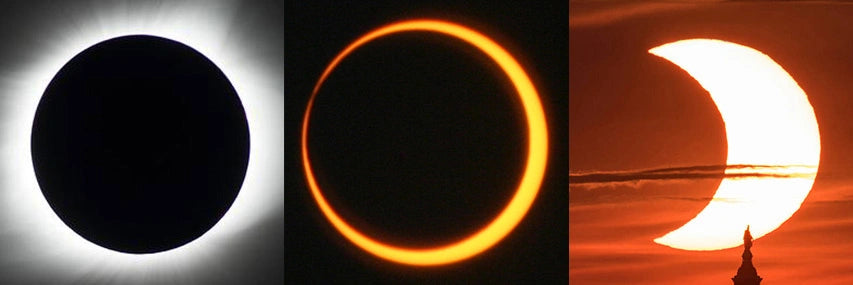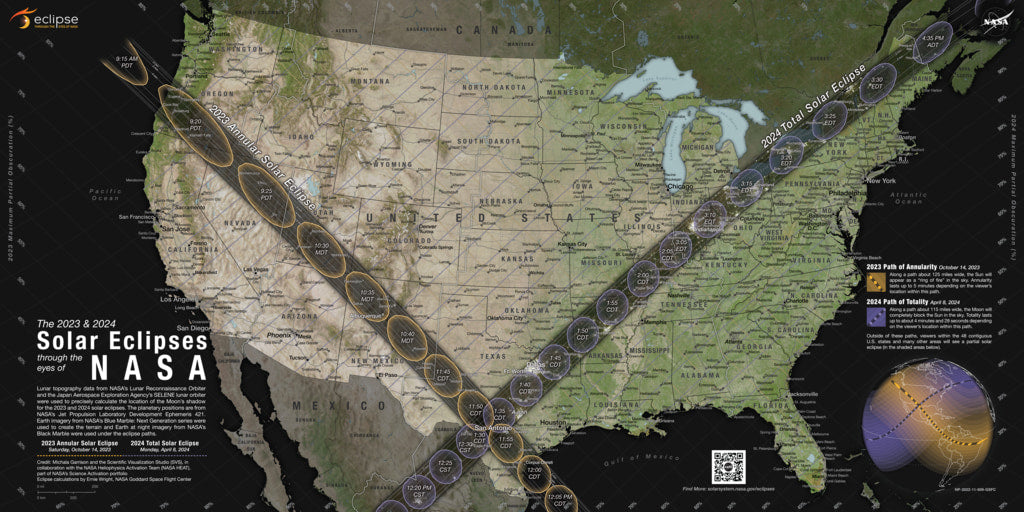What is an eclipse?
An eclipse is an awe-inspiring celestial event that drastically changes the appearance of the two biggest objects we see in our sky: our Sun and Moon. On Earth, people can experience solar eclipses when Earth, the Moon, and the Sun line up.
Safety is the number one priority when viewing a solar eclipse. Be sure you're familiar with and follow these safety guidelines when viewing an eclipse.
Know your eclipses!
There are four types of solar eclipses: total, partial, hybrid, and annular. The type of eclipse that people get to see depends on how the Moon aligns with Earth and the Sun, and how far away the Moon is from Earth.
There are three types of lunar eclipses: total, partial, and penumbral. At least two partial lunar eclipses happen every year, but total lunar eclipses are rare. Unlike a solar eclipse, it is always safe to look at a lunar eclipse with the naked eye.

Credits: Total eclipse (left): NASA/MSFC/Joseph Matus; annular eclipse (center): NASA/Bill Dunford; partial eclipse (right): NASA/Bill Ingalls
Total Solar Eclipse
A total solar eclipse happens when the Moon passes between the Sun and Earth, completely blocking the face of the Sun. People located in the center of the Moon’s shadow when it hits Earth will experience a total eclipse. The sky will darken, as if it were dawn or dusk. Weather permitting, people in the path of a total solar eclipse can see the Sun’s corona, the outer atmosphere, which is otherwise usually obscured by the bright face of the Sun. A total solar eclipse is the only type of solar eclipse where viewers can momentarily remove their eclipse glasses (which are not the same as regular sunglasses) for the brief period of time when the Moon is completely blocking the Sun. The next total solar eclipse in the U.S. will be on April 8, 2024.
Annular Solar Eclipse
An annular solar eclipse happens when the Moon passes between the Sun and Earth, but when it is at or near its farthest point from Earth. Because the Moon is farther away from Earth, it appears smaller than the Sun and does not completely cover the Sun. As a result, the Moon appears as a dark disk on top of a larger, bright disk, creating what looks like a ring around the Moon. The next annular eclipse in the U.S. will be on Oct. 14, 2023.
Partial Solar Eclipse
A partial solar eclipse happens when the Moon passes between the Sun and Earth but the Sun, Moon, and Earth are not perfectly lined up. Only a part of the Sun will appear to be covered, giving it a crescent shape. During a total or annular solar eclipse, people outside the area covered by the Moon’s inner shadow see a partial solar eclipse.
Hybrid Solar Eclipse
Because Earth's surface is curved, sometimes an eclipse can shift between annular and total as the Moon’s shadow moves across the globe. This is called a hybrid solar eclipse.

Source: NASA/Scientific Visualization Studio/Michala Garrison; eclipse calculations by Ernie Wright, NASA Goddard Space Flight Center
